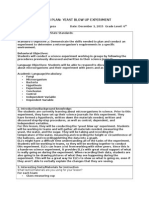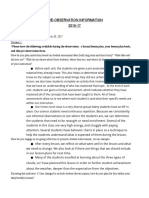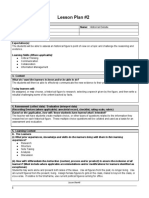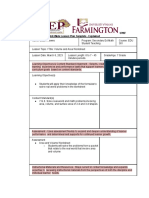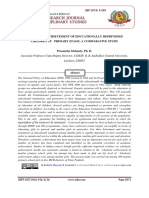Lesson Plan 4
Lesson Plan 4
Uploaded by
api-405577630Copyright:
Available Formats
Lesson Plan 4
Lesson Plan 4
Uploaded by
api-405577630Original Title
Copyright
Available Formats
Share this document
Did you find this document useful?
Is this content inappropriate?
Copyright:
Available Formats
Lesson Plan 4
Lesson Plan 4
Uploaded by
api-405577630Copyright:
Available Formats
UMU Lesson Plan Template
Name: Mollianne Dunn Date: 11/28/18
Grade Level: 7th Grade Class Period: 7/8
Subject: Science Lesson # & Title: Scientific Investigation
Function of the Lesson (check all that apply):
□ Introduce New Skill or Content
□ Practice
□ Review
□ Remediation/Re-teaching
Context for Learning and Planning Rationale:
Learner Attributes: There are a total of 24 students (12 boys and 12 girls) in the seventh grade classroom. The students are
from a rural district that is increasingly becoming more suburban. The vast majority of the class is Caucasian. This class is a
middle level class so there are no gifted students, low achieving students, or students with learning disabilities.
Classroom Environment: The classroom is composed of 12 tables; 2 tables are pushed together to make a pod that seats 4
students. There are 6 sets of pods to seat all 24 students in groups of 4 that allow for cooperative learning to occur. There are
7 students in the class who are easily distracted and constantly need reminded to stay on task. These students are separated
throughout the classroom with students who help them to remain on task during individual and cooperative learning times.
The 3 students that are the most distracted during focused and guided instruction are seated towards the front of the
classroom so the teacher can use proximity to prevent off topic discussions and other distractions. There is a Smartboard and
whiteboard at the front of the room that is visible to all students. Each student has access to their own Chromebook when
doing something that requires their use. The classroom has 8 sinks, science equipment, emergency shower, cabinets for
storage, and counter space that allow for various experiments. The walls are decorated with a periodic table, a giant
whiteboard Sudoku that the students can work on at their leisure, classroom rules, and some science posters. There is a fire
hydrant down the hallway.
Rationale: While planning the lesson, it is important to be aware and plan according to various cultures and socioeconomic
backgrounds. Students should be able to relate and understand all information taught no matter what their background is. The
information being taught in this lesson is not culture or socioeconomically specific so this should not be an issue. The lesson
is also planned in consideration for a diversity of learners. Not all students learn the same so it is important to present
information in many different forms. Multiple modalities are used throughout the lesson by the teacher in order to reach all
types of learning styles. For example, the teacher reads all of the examples in the beginning of the lesson aloud in order to
help auditory learners and kinesthetic learners benefit from all of the practice.
Content Standards: Grade Band Theme: This theme focuses on helping students use scientific inquiry to discover patterns,
trends, structures and relationships that may be inferred by simple principles. These principles are related to the properties or
interactions within and between systems.
Science Inquiry and Applications:
During the years of grades 5 through 8, all students must have developed the ability to: Identify questions that can be
answered through scientific investigations; Design and conduct a scientific investigation; Use mathematics, tools and
techniques to gather data and information; Analyze and interpret data; Develop descriptions, models, explanations and
predictions; Think critically and logically to connect evidence and explanations; Recognize and analyze alternative
explanations and predictions; and Communicate scientific procedures and explanations
Rationale: Science inquiry and applications is being taught because it is important for students to understand the basics of the
scientific method before implementing the scientific method into their learning. Science is built on using the scientific
method to make discoveries which are then taught in school. Everything the students learn went through the scientific method
Revised January 2018
and the students will use the scientific method throughout the rest of their science classes to learn. Some students may even
continue onto high learning and jobs that will require the use of the scientific method such as medical research or
engineering. In order to be able to properly use the scientific method, the students must understand all the steps of the
scientific method and what is involved. The students need to understand the importance of each step of the scientific method.
Each step has a purpose and by understanding the purpose, it helps students to know that their work is not useless but integral
to the final result. The scientific method helps students to organize information in a manner that promotes understanding and
learning.
This standard was taught earlier in the year, however, the students are still struggling to identify the independent and
dependent variable so they will review this material today.
Learning Objectives:
1. The students will be able to formulate an experimental idea, with 100% accuracy.
2. The students will be able to formulate a question for an experiment, with 100% accuracy
3. The students will be able to identify the independent and dependent variable in an experiment, with 100% accuracy.
Academic Language:
Scientific method: a method of procedure that has characterized natural science since the 17th century, consisting in
systematic observation, measurement, and experiment, and the formulation, testing, and modification of hypotheses
Variable: an element, feature, or factor that is liable to vary or change
Independent variable: a variable whose variation does not depend on that of another
Dependent variable: a variable whose value depends on that of another
Assessment Plan, Formative Assessment:
1. In order to check what the students have learned from previous lessons about independent and dependent variables,
the students will identify independent and dependent variables. The teacher will put example questions on the
SmartBoard and the students will identify the variables on a piece of paper. The teacher will go over the examples
by calling on students and the teacher will collect the sheets of paper. The teacher will look over each students’
papers in order to check which students are struggling still. The teacher will check on those students during
independent work time.
2. In order to check what the students learned from the examples and review, the students will complete worksheet #1.
The worksheet is a lot of experiment examples and the students have to identify the independent and dependent
variables for each. The teacher will review some of the questions and collect the worksheet. The teacher will make
note of who is still struggling and address those students in the following lesson.
Assessment Plan, Summative Assessment:
1. To check to see if the students have mastered the lesson material and objectives, the students will complete an exit
ticket. By the end of the lesson the students should be able to formulate their own experimental idea, formulate a
question, and identify the independent and dependent variables. The exit ticket will require the students to come up
with one experimental idea, formulate one question, and identify the independent and dependent variables. In order
for the students to meet mastery, the must complete each part of the exit ticket correctly to reach an accuracy of
100%.
Procedures, Lesson Introduction: (5 minutes)
1. The teacher will begin class by providing examples of experiments on the SmartBoard. The students will write on a
piece of paper the independent and dependent variables for each example. After a few minutes, the teacher will call
on students and go over each example. The teacher will collect the sheets of paper.
Procedures, Lesson Body: (30 minutes)
1. The teacher will review what an independent and dependent variable is. The teacher will call on students to explain
each one.
Revised January 2018
2. The teacher will handout worksheet #1 and explain the directions. The students are to read each situation on the
paper and determine the independent and dependent variable. The teacher will walk around during this time
checking on the students’ work and progress.
3. Once the students begin to finish, the teacher will bring the class back together to go over 4 of the questions.
Procedures, Lesson Closure: (10 minutes)
1. The teacher will end class by having the students complete an exit ticket. The students are to come up with an
experimental idea. This experiment will not be tested so the students can be as creative as they would like to be. The
students will then formulate the scientific question that goes with their experiment and identify the independent and
dependent variables.
Differentiation, Individualized Instruction, and Assessment:
1. During individual work, the teacher will begin by casually checking on the tables to ensure that the 7 students who
are easily distracted are on task. Proximity to the students help a few of the students to get on task while the other
few need verbally reminders to get started. The teacher will not make a big deal of checking on these 7 students by
checking on the other students’ progress as well. This will ensure that the students are not embarrassed, but keeps all
of the students on task.
2. For the students that are able to easily identify the independent and dependent variables, the teacher will challenge
them to begin to formulate the scientific questions based on the experiment explained. If the students need even
more of a challenge, the teacher will encourage them to begin to create the hypotheses for each experiment.
Instructional Materials and Support:
Example experiments
SmartBoard
Paper
Pencils
Worksheet #1
Research and Theory Commentary:
1. The learning environment is set up in support of Lev Vygotsky’s theory, which focuses on the importance of social
interaction and collaborative group work for learning. The tables are set up so during individual work, students are
able to work together or ask their peers questions whenever needed. Often times students have different ways of
looking at the situation which can benefit their peers rather than the teacher explaining it again. The teacher is still
able to intervene when needed. Furthermore, adolescents in the middle school are most influenced by their peers and
social interactions at this age are extremely important.
2. B. F. Skinner’s theory is that positive reinforcement encourages a behavior and negative reinforcement pushes a
student away from a behavior. This theory is implemented in the lesson by the teacher providing positive
reinforcement when students participate in class. This will encourage students to keep participating and encourage
other students to participate more. Also, students in the middle school often care more about their peers than
teachers. By encouraging students to keep participating, then other students will be encouraged to follow what their
peers are doing.
3. Edward Thorndike developed the first three “Laws of learning” one of which is the law of exercise. This law focuses
on practicing what is learned. Students cannot learn effectively by only watching. Students need to practice what is
taught in order to learn and master a skill. This is reflected in the lesson plan because the lesson includes chances to
practice with the examples, a lot of practice problems, and the exit ticket.
Cultural Responsiveness, Equity, and Inclusion Commentary:
1. During class discussion times, students are challenged to explain and support their work. During individual learning,
students are encouraged to work together when stuck or to check their work. This allows for students to be able to
critique each other’s work.
2. Students from all cultures are able to relate to the lesson because the examples are relatable to their lives and
people’s lives around them. They include examples including ones about students, grades, family pets, etc. This
allows for the students to relate to the material.
Revised January 2018
Use of Technology Commentary (if applicable):
Not Applicable
Reflection and Instructional Commentary (if applicable):
The students seemed to have a much better understanding of independent and dependent variables by the end of class. The
experiments they came up with were really creative and interesting. The practice worksheet helped a lot.
Revised January 2018
Example Problems
Example #1: Music may help people relax. John got two groups of people together. He took everybody’s pulse and blood
pressure. Then he allowed one group to listen to soothing music while the other group sat in silence. After the song was over,
he measured everyone’s pulse and blood pressure again.
Example #2: Preservatives, like salt, help keep food fresh. Katie made 12 loaves of bread using the same recipe and baking
method. In 6 of them she used salt, in 6 of them she used no salt. After the loaves were baked, she placed each of the loaves
in a plastic bad and left them close together on the counter in the kitchen. Each day she looked at them to see if any mold had
started to grow.
Example #3: Rocco made an air-pressure device that could launch potatoes. He added air to the device using his bicycle tire
pump. For 10 launches, he used 10 pumps of air. For another 10 launches, he used 20 pumps of air. After launching each
potato, he carefully measured how far it travelled.
Revised January 2018
Worksheet #1
Name _______________ Pd ___________________
Date________________ Variables: Ind. and Dep.
Independent and Dependent Variables: ANSWERS
Part 1 Directions: Identify the independent and dependent variables in the following statements.
1) The more time people spend using social media, the less they read books.
Independent Variable: Time on Social Media
Dependent Variable: Less books read
2) Drinking energy drinks makes people more aggressive.
Independent Variable: Drinking energy drinks
Dependent Variable: Aggressive behavior
3) Taking a nap in the afternoon makes people more focused for the rest of the day.
Independent Variable: Time spent napping in the afternoon
Revised January 2018
Dependent Variable: Focus
4) Spending time with a family dog decreases the amount of stress someone is feeling.
Independent Variable: Spending time with a family dog
Dependent Variable: Amount of stress someone is feeling.
5) Eating breakfast in the morning increases the ability to learn in school.
Independent Variable: Eating breakfast
Dependent Variable: Ability to learn
Part 2 Directions…More Challenging: Identify the independent and dependent variables in the following
descriptions of experiments:
1) Students watched a cartoon either alone or with others and then rated how funny they found the
cartoon to be.
Revised January 2018
Independent Variable: Watching cartoons solo or with others
Dependent Variable: How funny the cartoon is
2) A comprehension test was given to students after they had studied textbook material either in silence or
with the television turned on.
Independent Variable: Studying with or without TV
Dependent Variable: Achievement on a test
3) Some elementary school teachers were told that a child’s parents were college graduates, and other
teachers were told that the child’s parents had not finished high school; they then rated the child’s grades.
Independent Variable: Education of parents
Dependent Variable: Children’s grades
4) Workers at a company were assigned to one of two conditions: One group completed a stress
management training program; another group of workers did not participate in the training. The number of
sick days taken by these workers was examined for the next 2 months.
Independent Variable: Stress Management Training
Revised January 2018
Dependent Variable: Sick days taken
5) Students at a University were split into two groups and each received a different text for a philosophy
course. Once group received a traditional text book, while the other received an interactive textbook on a
tablet computer. After the course, the final exam grades between the two groups of students was compared.
Independent Variable: Type of book used in college class
Dependent Variable: Final exam grade
Revised January 2018
You might also like
- The Power of 2X2 Matrix PDFDocument10 pagesThe Power of 2X2 Matrix PDFguru9anandNo ratings yet
- National University Lesson Plan Dec1 MDocument6 pagesNational University Lesson Plan Dec1 Mapi-320720255100% (1)
- FM HRD 001 L D Proposal Template 2Document2 pagesFM HRD 001 L D Proposal Template 2BENJ AMIN100% (4)
- Dip Trans HandbookDocument24 pagesDip Trans HandbookCeleste EspinaNo ratings yet
- Lesson Plan 160204 Scientific MethodDocument7 pagesLesson Plan 160204 Scientific Methodapi-309206763100% (1)
- Tesp 501 - Final Signature AssignmentDocument14 pagesTesp 501 - Final Signature Assignmentapi-356157870No ratings yet
- Ell Lesson PlanDocument3 pagesEll Lesson Planapi-270826504No ratings yet
- Velarde Asu 0010E 12611 PDFDocument87 pagesVelarde Asu 0010E 12611 PDFsalmazz100% (1)
- Claflin University School of EducationDocument4 pagesClaflin University School of Educationapi-216728214No ratings yet
- Observation 5 ScienceDocument6 pagesObservation 5 Scienceapi-346507216No ratings yet
- Day Lesson PlanDocument22 pagesDay Lesson Planamanda_weeks25No ratings yet
- 9 Lesson 3Document3 pages9 Lesson 3api-372464959No ratings yet
- Name: Nicole Liu - Grade Level Being Taught: 1st Subject/Content: Science/Conclusion Group Size: Whole Date of Lesson: 11/9/16Document8 pagesName: Nicole Liu - Grade Level Being Taught: 1st Subject/Content: Science/Conclusion Group Size: Whole Date of Lesson: 11/9/16api-295768366No ratings yet
- Lesson Plan 2Document3 pagesLesson Plan 2api-450523196No ratings yet
- National University Lesson Plan Nov9 VDocument5 pagesNational University Lesson Plan Nov9 Vapi-320720255No ratings yet
- AshleystreitmanDocument4 pagesAshleystreitmanapi-316235864No ratings yet
- Webster Format For Lesson Plan 1 MicrolessonDocument10 pagesWebster Format For Lesson Plan 1 MicrolessonVictoria WarrenNo ratings yet
- Dice DIce Baby Activity and Practice Quiz Lesson Observation 3Document12 pagesDice DIce Baby Activity and Practice Quiz Lesson Observation 3Victoria WarrenNo ratings yet
- Evolutionary Processes For Unit 5 Lesson 5 Study Day (1) .Docx THIS ONEDocument9 pagesEvolutionary Processes For Unit 5 Lesson 5 Study Day (1) .Docx THIS ONEVictoria WarrenNo ratings yet
- College of Saint Mary Lesson Plan Format With Lesson ReflectionDocument4 pagesCollege of Saint Mary Lesson Plan Format With Lesson Reflectionapi-312091622No ratings yet
- 9 Lesson 7Document4 pages9 Lesson 7api-372464959No ratings yet
- Sorting Lesson PlanDocument4 pagesSorting Lesson Planapi-267077176No ratings yet
- Nottoway Classroom Observation Form 1Document12 pagesNottoway Classroom Observation Form 1api-301641435100% (1)
- Educ 513 Procedure Lesson 1Document7 pagesEduc 513 Procedure Lesson 1api-364124618No ratings yet
- Course Outline-Science 7-2014-2015Document5 pagesCourse Outline-Science 7-2014-2015api-262837322No ratings yet
- Fs 3Document45 pagesFs 3slykeeper95% (19)
- Jason Howes Volume Area Lesson Plan 2Document3 pagesJason Howes Volume Area Lesson Plan 2api-664138535No ratings yet
- Educ 433 533 Observation Report ActualDocument6 pagesEduc 433 533 Observation Report Actualapi-397168554No ratings yet
- Educ685 Air Masses and Fronts Lesson PlanDocument3 pagesEduc685 Air Masses and Fronts Lesson Planapi-261868573No ratings yet
- Plickers LPDocument4 pagesPlickers LPapi-312091622No ratings yet
- SyllabusDocument3 pagesSyllabusapi-293905922No ratings yet
- Lesson 1Document3 pagesLesson 1api-459019139No ratings yet
- Strategy ExperimentationDocument10 pagesStrategy ExperimentationerikNo ratings yet
- Evolutionary Processes For Unit 5 Lesson 1 OnlyDocument7 pagesEvolutionary Processes For Unit 5 Lesson 1 OnlyVictoria WarrenNo ratings yet
- Edu 201 Field Observation AssignmentDocument13 pagesEdu 201 Field Observation Assignmentapi-511592227No ratings yet
- Plan For Managing The Learning Environment Brooklynn Ramos: Graduate School of EducationDocument11 pagesPlan For Managing The Learning Environment Brooklynn Ramos: Graduate School of Educationapi-537113055No ratings yet
- Lesson Plan Template: Essential QuestionDocument4 pagesLesson Plan Template: Essential Questionapi-531359203No ratings yet
- Delivery Plan 2022 1Document3 pagesDelivery Plan 2022 1api-671085343No ratings yet
- Policies and Procedures SampleDocument4 pagesPolicies and Procedures SampleJj AitengNo ratings yet
- Classroom Observation Assignment-Form 1 Hidayet GozetenDocument3 pagesClassroom Observation Assignment-Form 1 Hidayet Gozetenapi-241333531No ratings yet
- Grade 8 Science: 2021-2022 SyllabusDocument2 pagesGrade 8 Science: 2021-2022 SyllabusLovely TrashNo ratings yet
- Lesson Plan-Amazing Gobbstopper Diffusion LabDocument3 pagesLesson Plan-Amazing Gobbstopper Diffusion Labapi-140174622No ratings yet
- Observation AssignmentDocument9 pagesObservation Assignmentapi-299774881No ratings yet
- Lesson Planning 2Document8 pagesLesson Planning 2api-294830212No ratings yet
- Name: Irene Poulton Pima Course:: Formal Lesson Plan TemplateDocument3 pagesName: Irene Poulton Pima Course:: Formal Lesson Plan Templateapi-318500225No ratings yet
- Third Grade Math LessonDocument6 pagesThird Grade Math Lessonapi-591042996No ratings yet
- Classroom Action Research " Penelitian Tindakan Kelas"Document4 pagesClassroom Action Research " Penelitian Tindakan Kelas"ida ayu tungga dewiNo ratings yet
- Mait 404 Lesson 8Document5 pagesMait 404 Lesson 8api-300525347No ratings yet
- Math Measurement-LessonplanDocument17 pagesMath Measurement-Lessonplanapi-300158509No ratings yet
- Lesson Plan DesignDocument4 pagesLesson Plan Designapi-344763872No ratings yet
- Recount Lesson Plan-Oct PracticumDocument5 pagesRecount Lesson Plan-Oct Practicumapi-282820976No ratings yet
- Name: - Nicole Liu - Grade Level Being Taught: 1st Subject/Content: Science/Procedures & Materials Group Size: Whole Date of Lesson: 11/8/16Document8 pagesName: - Nicole Liu - Grade Level Being Taught: 1st Subject/Content: Science/Procedures & Materials Group Size: Whole Date of Lesson: 11/8/16api-295768366No ratings yet
- Teacher Work SampleDocument12 pagesTeacher Work Sampleapi-444858079No ratings yet
- Living and Non Living Things Life Cycles x3 Lesson PlansDocument15 pagesLiving and Non Living Things Life Cycles x3 Lesson Plansapi-267341620No ratings yet
- Ida Ayu (CAR)Document4 pagesIda Ayu (CAR)ida ayu tungga dewiNo ratings yet
- Lesson Plan Design: F. Students Know Plants Use Carbon Dioxide (CO and EnergyDocument5 pagesLesson Plan Design: F. Students Know Plants Use Carbon Dioxide (CO and Energyapi-323520361No ratings yet
- ASSURE MODEL LESSON PLAN (Castromayor)Document2 pagesASSURE MODEL LESSON PLAN (Castromayor)sshernalim07No ratings yet
- Sixth Grade Reading SyllabusDocument8 pagesSixth Grade Reading Syllabusapi-263179720No ratings yet
- Lesson PlanDocument7 pagesLesson Planapi-317738807No ratings yet
- Management PlanDocument8 pagesManagement Planapi-350315138No ratings yet
- Methods Unit Plan Madeline HunterDocument5 pagesMethods Unit Plan Madeline Hunterapi-432999648No ratings yet
- Lesson Plan DesignDocument6 pagesLesson Plan Designapi-306617898No ratings yet
- The Scientific Method Lesson PlanDocument6 pagesThe Scientific Method Lesson Planapi-271874263100% (1)
- Informational Text Toolkit: Research-based Strategies for the Common Core StandardsFrom EverandInformational Text Toolkit: Research-based Strategies for the Common Core StandardsNo ratings yet
- Peru Resume 2020Document1 pagePeru Resume 2020api-405577630No ratings yet
- Artifact For Standard 6Document1 pageArtifact For Standard 6api-405577630No ratings yet
- Artifact For Standard 2Document6 pagesArtifact For Standard 2api-405577630No ratings yet
- Artifact For Standard 1Document5 pagesArtifact For Standard 1api-405577630No ratings yet
- Tesol ModuleDocument70 pagesTesol Modulealfonso yuNo ratings yet
- Foucauldian EducationDocument13 pagesFoucauldian EducationSebastian LeonNo ratings yet
- NSTP 101 MidtermDocument2 pagesNSTP 101 MidtermMark JayNo ratings yet
- OSDocument3 pagesOSMichelle Anne Legaspi BawarNo ratings yet
- Five Things An Unloving Mother Never DoesDocument4 pagesFive Things An Unloving Mother Never Doessalalepe100% (2)
- Syllabus CEE220Document5 pagesSyllabus CEE220appstore500No ratings yet
- ACTION RESEARCH FINAL - EditedDocument18 pagesACTION RESEARCH FINAL - EditedClaudineNo ratings yet
- Oxford HANDBOOK 2017Document41 pagesOxford HANDBOOK 2017gunseg4No ratings yet
- Lesson Plan 2Document3 pagesLesson Plan 2api-371744862No ratings yet
- DVBS Training WorkshopDocument39 pagesDVBS Training WorkshopZarah Jane LimNo ratings yet
- Junior Assistant in Telangana State Road Transport CorporationDocument23 pagesJunior Assistant in Telangana State Road Transport CorporationsuriblacksNo ratings yet
- ED 345 Calvin College Lesson Planning Form: CCSS - Math.Content.2.MD.B.5Document2 pagesED 345 Calvin College Lesson Planning Form: CCSS - Math.Content.2.MD.B.5api-252213240No ratings yet
- Curriculum Evaluation PPT - 5 MinutesDocument12 pagesCurriculum Evaluation PPT - 5 MinutesRina Amin100% (1)
- Lesson Plan Student InterviewDocument4 pagesLesson Plan Student Interviewapi-429061662No ratings yet
- Registration Form - Synergies in Communication - 6th Edition - 2017-Drobot AnaDocument3 pagesRegistration Form - Synergies in Communication - 6th Edition - 2017-Drobot AnaAna IrinaNo ratings yet
- TLE BPP10 Q4 M3Document14 pagesTLE BPP10 Q4 M3Winter Mage100% (3)
- Bsba 1-4 Lacking of Copies: QuestionsDocument2 pagesBsba 1-4 Lacking of Copies: QuestionsAndrew Arciosa CalsoNo ratings yet
- NEBOSH International General Certificate in Occupational Health and SafetyDocument10 pagesNEBOSH International General Certificate in Occupational Health and SafetyVicky VigneshNo ratings yet
- Lesson PlanDocument5 pagesLesson PlanShanoof Sharaf100% (1)
- Welcome To rm2&3 2015Document1 pageWelcome To rm2&3 2015api-259333489No ratings yet
- 21st Century Learning: Research, Innovation and PolicyDocument13 pages21st Century Learning: Research, Innovation and PolicyHeka Arcana PutraNo ratings yet
- Dr. Prasamita MohantyDocument16 pagesDr. Prasamita MohantyAnonymous CwJeBCAXpNo ratings yet
- The Silence - Barriers and Facilitators To Inclusion of Lesbian Gay and Bisexual Pupils in Scottish SchoolsDocument241 pagesThe Silence - Barriers and Facilitators To Inclusion of Lesbian Gay and Bisexual Pupils in Scottish Schoolsusuariosdelserra1727100% (1)
- Resume C Dues 10-3-16 For WeeblyDocument3 pagesResume C Dues 10-3-16 For Weeblyapi-301252690No ratings yet
- Western Mindanao State University: College of Teacher EducationDocument3 pagesWestern Mindanao State University: College of Teacher EducationAlwyn SacandalNo ratings yet
- The Bio Guide PreviewDocument41 pagesThe Bio Guide PreviewaskhachaNo ratings yet






